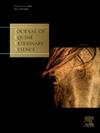Follicular growth, ovulation, and pregnancy responses to PGF-indued luteolysis and spontaneous return to estrus in Standardbred mares with large diestrous follicles
IF 1.3
3区 农林科学
Q2 VETERINARY SCIENCES
引用次数: 0
Abstract
The objective of this study was to compare the fertility of diestrous mares with a follicle ≥ 30 mm in diameter treated with prostaglandin F2α (PGF) (PGF group) or left untreated for 7 days (SP group). Standardbred mares (n = 46) were assigned randomly to the SP (n = 23) and PGF groups (n = 23) when they were identified with a corpus luteum (CL) of unknown age and a follicle ≥ 30 mm in diameter (Day 0). The most frequent outcome in the PGF group was estrus and ovulation of the dominant follicle (74 %), while the outcomes of the SP mares 7 days after Day 0 were more variable: estrus and follicle regression (30 %), diestrous ovulation (22 %) and diestrus along with follicle regression (26 %) of the dominant follicles. Therefore, more mares from the PGF group were bred within 7 days after treatment (83 %) than SP mares (9 %; P < 0.001). The 14-day pregnancy rate tended to be higher in SP mares (65 %; P = 0.092; OR = 2.716) than in PGF mares (39 %), and more artificial inseminations (AI) were required in the PGF than in the SP group to reach a 14-day pregnancy (1.7 ± 0.6 and 1.3 ± 0.5, respectively; P = 0.02). However, the interval from Day 0 to 14-day pregnancy and the end of season pregnancy rates were similar (P > 0.1) in both groups (SP: 39.6 ± 23.2 days and 87 %; PGF: 37.4 ± 16.3 days and 96 %, respectively). In conclusion, there is no advantage of waiting for diestrous mares with a large follicle to enter estrus spontaneously over administering a PGF treatment. However, more AIs were needed to obtain a pregnancy in the PGF than in the SP group.
求助全文
约1分钟内获得全文
求助全文
来源期刊

Journal of Equine Veterinary Science
农林科学-兽医学
CiteScore
2.70
自引率
7.70%
发文量
249
审稿时长
77 days
期刊介绍:
Journal of Equine Veterinary Science (JEVS) is an international publication designed for the practicing equine veterinarian, equine researcher, and other equine health care specialist. Published monthly, each issue of JEVS includes original research, reviews, case reports, short communications, and clinical techniques from leaders in the equine veterinary field, covering such topics as laminitis, reproduction, infectious disease, parasitology, behavior, podology, internal medicine, surgery and nutrition.
 求助内容:
求助内容: 应助结果提醒方式:
应助结果提醒方式:


